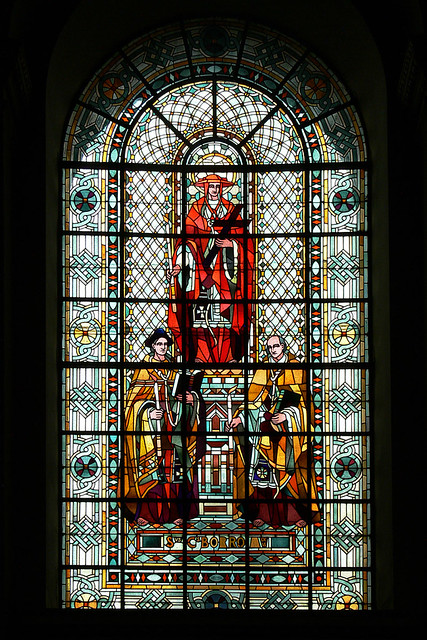Duhaut, Amiens

This window presents St Vedast (St Vaast), the first bishop of Arras–Cambrai and one of the foundational missionaries of northern France. Shown in the upper register in episcopal vestments with crozier uplifted, Vedast appears as the spiritual protector of the diocese and principal patron of the cathedral. Below, two figures approach him, likely representing early catechumens or newly converted Franks, recalling his documented role in the evangelisation of the region and his tutelage of King Clovis before the latter’s baptism at Reims.
Attribution
On stylistic grounds, the window can be assigned with confidence to the Ateliers Duhaut of Amiens, one of the principal stained-glass studios active in northern France during the post–First World War reconstruction. Duhaut’s characteristic features, heavy, decisive leading, broad colour planes, angular drapery built from polygonal segments, and strong geometric borders with interlace motifs, are all present here.
The muted yet rich palette of greens, ochres, brick-reds, and soft blues further corresponds to the atelier’s interwar production, as does the orderly architectural framing and the emphasis on graphic clarity over naturalistic modelling. Duhaut executed numerous windows for churches in Artois and Picardy during the 1920s–1940s, many of them dedicated to local saints, which strengthens the attribution.
Historical Context
Arras Cathedral suffered heavy damage during the First World War, resulting in the loss of nearly all its medieval glazing. A major restoration campaign between the 1920s and 1950s commissioned new windows from leading French ateliers. This window forms part of that programme, reflecting the period’s preference for combining medieval iconography with modern Art Deco–influenced geometry.
Iconography
-
Upper panel: St Vedast stands frontally, haloed, raising his right hand in blessing and holding a crozier in his left.
-
Lower panel: Two male figures approach him, one with an expression of supplication, the other with a gesture of inquiry or devotion.
-
Background: Architectural motifs evoke early Christian Arras; dense geometric borders frame the scene with Celtic- and Romanesque-inspired patterns typical of Duhaut’s studio.
Significance
The window is one of the most distinctive examples of Arras Cathedral’s early 20th-century glazing, encapsulating the post-war revival of regional saints, the visual vocabulary of interwar stained glass, and the important role of the Ateliers Duhaut in reshaping the region’s ecclesiastical art landscape. It stands as a testament to both local devotional identity and the broader artistic language of northern France between the wars.
